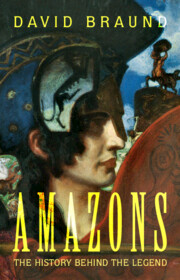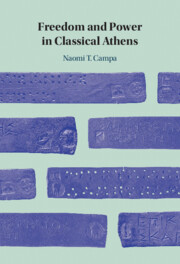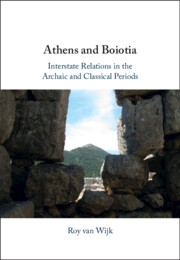Refine search
Actions for selected content:
95 results
Chapter 5 - Public Generosity and Models of Leadership in Classical Athens
-
-
- Book:
- Leadership in the Ancient World
- Published online:
- 14 September 2025
- Print publication:
- 16 October 2025, pp 110-132
-
- Chapter
- Export citation
Chapter 6 - Athenian Politics and the Peloponnesian War
-
-
- Book:
- Reassessing the Peloponnesian War
- Published online:
- 21 August 2025
- Print publication:
- 04 September 2025, pp 148-195
-
- Chapter
- Export citation
Chapter 3 - The Causes of the Peloponnesian War
-
-
- Book:
- Reassessing the Peloponnesian War
- Published online:
- 21 August 2025
- Print publication:
- 04 September 2025, pp 42-62
-
- Chapter
- Export citation
Chapter 4 - The Athenian Empire and the Peloponnesian War
-
-
- Book:
- Reassessing the Peloponnesian War
- Published online:
- 21 August 2025
- Print publication:
- 04 September 2025, pp 63-92
-
- Chapter
- Export citation
Chapter 7 - Greek Constitutional Thinking and the Peloponnesian War
-
-
- Book:
- Reassessing the Peloponnesian War
- Published online:
- 21 August 2025
- Print publication:
- 04 September 2025, pp 196-224
-
- Chapter
- Export citation
Egyptian grain to Athens: contexts of Philochoros 328 F 119
-
- Journal:
- The Journal of Hellenic Studies , First View
- Published online by Cambridge University Press:
- 02 June 2025, pp. 1-6
-
- Article
-
- You have access
- Open access
- HTML
- Export citation
Chapter 2 - Orator 2.0 (79–71)
-
- Book:
- Cicero
- Published online:
- 10 June 2025
- Print publication:
- 29 May 2025, pp 66-88
-
- Chapter
- Export citation
6 - Musical Empires
- from Part II - Aelius Aristides’ Lyric
-
- Book:
- Aelius Aristides and the Poetics of Lyric in Imperial Greek Culture
- Published online:
- 01 May 2025
- Print publication:
- 15 May 2025, pp 224-269
-
- Chapter
- Export citation
4 - Selecting Tragedies for Audiences and Readers
-
- Book:
- The Performance Reception of Greek Tragedy in Ancient Theatres
- Published online:
- 20 March 2025
- Print publication:
- 03 April 2025, pp 218-268
-
- Chapter
- Export citation

Amazons
- The History Behind the Legend
-
- Published online:
- 26 March 2025
- Print publication:
- 24 April 2025
3 - Ancient Greece
-
-
- Book:
- The Cambridge History of Strategy
- Published online:
- 06 January 2025
- Print publication:
- 09 January 2025, pp 53-72
-
- Chapter
- Export citation
3 - Agora and Emporia
-
- Book:
- World Cities in History
- Published online:
- 12 December 2024
- Print publication:
- 19 December 2024, pp 47-71
-
- Chapter
- Export citation
THE POTIDAEA EPIGRAM AND EURIPIDES’ SUPPLIANT WOMEN: AN INTERTEXTUAL READING
-
- Journal:
- The Classical Quarterly / Volume 74 / Issue 2 / December 2024
- Published online by Cambridge University Press:
- 19 May 2025, pp. 452-460
- Print publication:
- December 2024
-
- Article
-
- You have access
- Open access
- HTML
- Export citation
Chapter 2 - Acting versus Sincerity
-
- Book:
- Democracy, Theatre and Performance
- Published online:
- 17 May 2024
- Print publication:
- 27 June 2024, pp 39-62
-
- Chapter
- Export citation
Chapter 4 - Aeschylus’ Persians
-
- Book:
- Choral Tragedy
- Published online:
- 25 April 2024
- Print publication:
- 02 May 2024, pp 93-111
-
- Chapter
- Export citation

Freedom and Power in Classical Athens
-
- Published online:
- 04 April 2024
- Print publication:
- 11 April 2024
-
- Book
-
- You have access
- Open access
- Export citation
Interorganizational Knowledge Transfer in Mass Gatherings: Exploring the Health and Safety Stakeholders’ Perceptions Participating in the Athens Marathon
-
- Journal:
- Prehospital and Disaster Medicine / Volume 39 / Issue 2 / April 2024
- Published online by Cambridge University Press:
- 15 March 2024, pp. 163-169
- Print publication:
- April 2024
-
- Article
-
- You have access
- Open access
- HTML
- Export citation

Athens and Boiotia
- Interstate Relations in the Archaic and Classical Periods
-
- Published online:
- 29 February 2024
- Print publication:
- 25 January 2024
-
- Book
-
- You have access
- Open access
- Export citation
One - Sculpting Divine Music
-
- Book:
- Divine Music in Archaic and Classical Greek Art
- Published online:
- 01 February 2024
- Print publication:
- 29 February 2024, pp 30-71
-
- Chapter
- Export citation
Introduction
-
- Book:
- Divine Music in Archaic and Classical Greek Art
- Published online:
- 01 February 2024
- Print publication:
- 29 February 2024, pp 1-29
-
- Chapter
- Export citation
